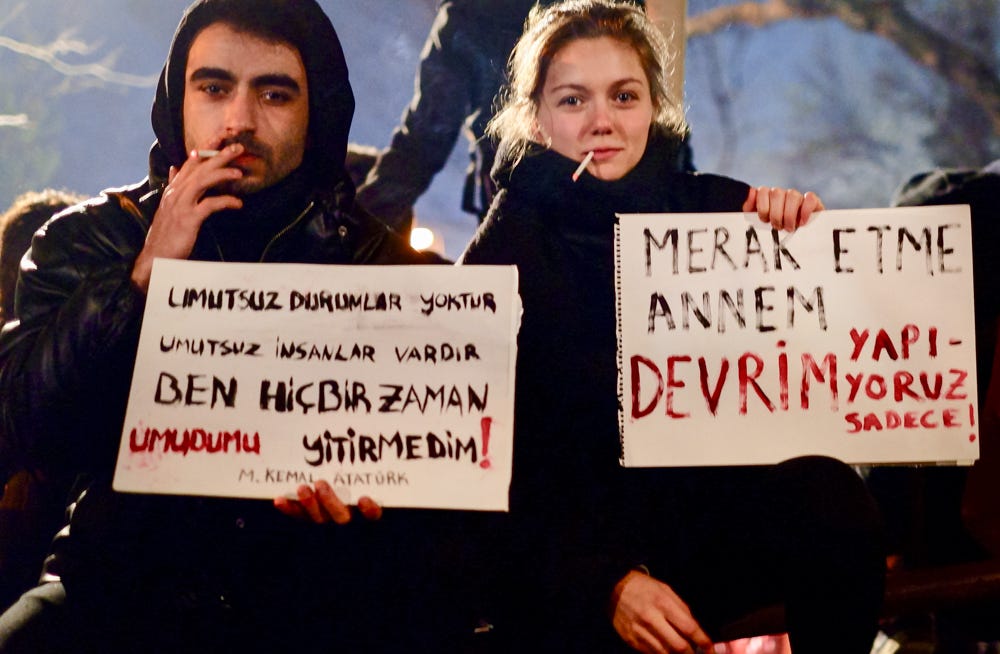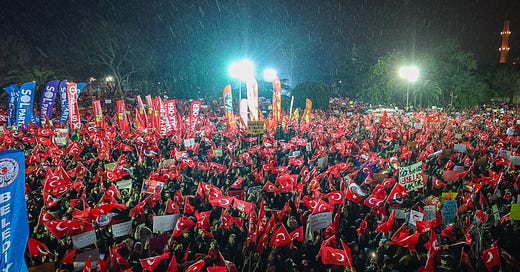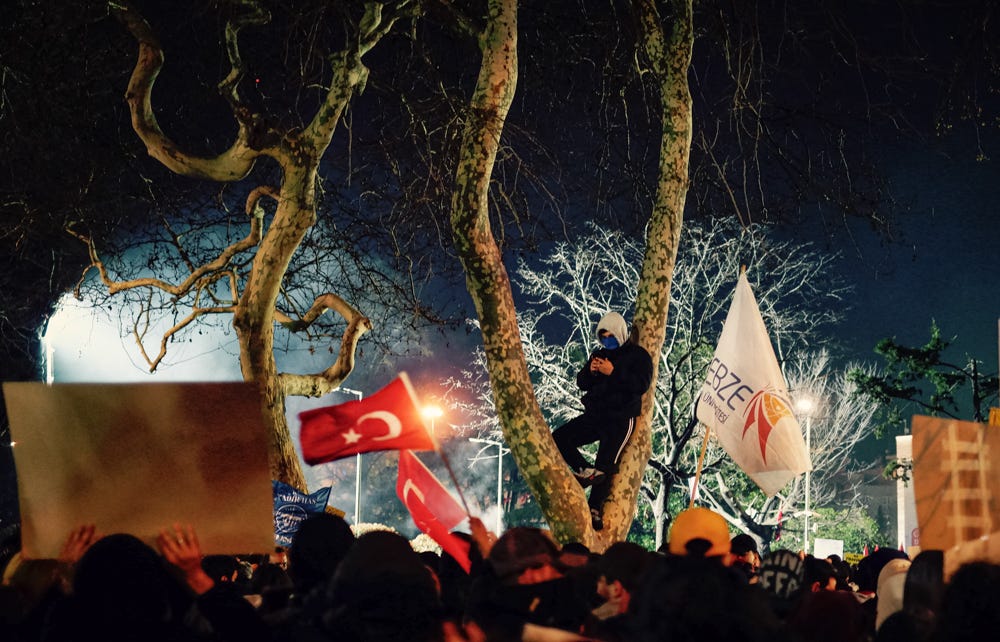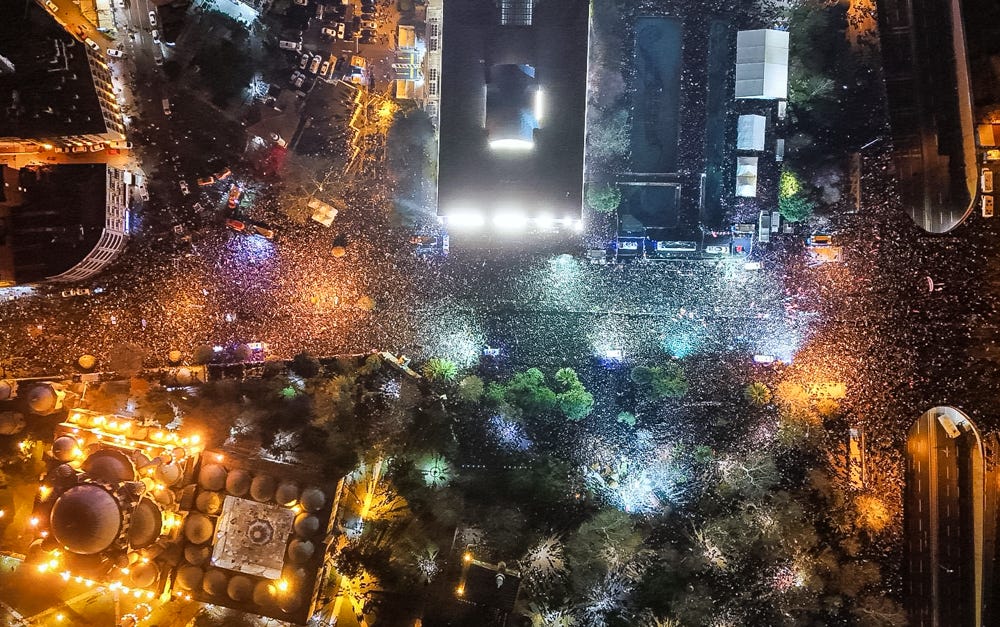İSTANBUL — Under light rain and heavy pepper spray, a large crowd of protestors stood their ground against riot police in Saraçhane, İstanbul, Sunday night. The two groups clashed between volleys of tear gas near the Valens Aqueduct until after midnight when security forces changed tactics.
Police officers soon chased demonstrators on foot and beat them to the ground in an effort to scatter the remaining crowd.
As on previous nights, protestors had sought refuge inside the İstanbul Metropolitan Municipality building in Saraçhane. Many ambulances were deployed here and several mobile clinics were treating injured demonstrators along with those heavily impacted by the tear gas – the fumes of which could be felt from a kilometer away.
Just like during Gezi, Turkey’s last major protests in 2013, demonstrators were on hand with spray bottles mixed with water and a liquid antacid to help relieve those choking on the tear gas. But unlike Gezi, in which the police were caught off guard by the size of the crowds, the security forces appeared well prepared this time.
The current protests began Mar. 19 with the detention of İstanbul Mayor Ekrem İmamoğlu on a wide range of charges that government opponents say are an attempt to sideline the most likely challenger to Pres. Recep Tayyip Erdogan’s 22-year rule.
In the face of growing arrest numbers, government bans on demonstrations and public transportation closures, massive rallies are expected to continue every evening this week, not just in İstanbul but also in other major cities throughout Turkey.
Leading the charge is main opposition Republican People’s Party (CHP) chair Özgür Özel, who Sunday night called on demonstrators to take to the streets and defend the democratically-elected mayor.
"Starting [Monday] and the days after, at 8:30 PM, in squares and areas to be announced across Turkey and in İstanbul, we will begin to stand together, escalate the struggle, and claim our future. We will not stop until we take back Mayor Ekrem, our presidential candidate,” Özel said.
At the same time, authorities have clamped down with countermeasures against protesters and media professionals documenting events on the ground as seven prominent İstanbul photojournalists were detained in dawn raids Monday morning. Meanwhile, observers are watching for signs of further escalation and instability in Turkey.
“Ultimately, I fear that things may get worse before they get better,” said Ayfer Karakaya-Stump, an assoc. prof. of history at the College of William & Mary in Virginia.
“The response of both the opposition and the public in the coming weeks will be crucial in determining whether this moment fizzles out or becomes a genuine turning point in Turkish politics,” she added.
According to Interior Min. Ali Yerlikaya, 1,133 protesters have been detained in Turkey since the arrest of İstanbul Mayor Ekrem İmamoğlu. The İstanbul Governor’s Office, which reports to the Interior Ministry, did not respond to immediate requests for comment.
Driving factors
The demonstrations were sparked by the detention of popular İstanbul Mayor Ekrem İmamoğlu, who was poised to challenge Erdoğan in presidential elections in 2028 – or earlier.
Yet last week, İmamoğlu's diploma was invalidated, rendering him ineligible as a presidential candidate, and he was subsequently taken into custody on Wednesday before being formally arrested Sunday, Mar. 23, on corruption charges that CHP members have blasted as politically motivated.
Following İmamoğlu's detention, the opposition party called on supporters to gather at the municipality headquarters in Saraçhane, and the demonstrations have grown with each passing day from tens of thousands Thursday, to 300,000 on Friday, and perhaps double that on Saturday and Sunday.
“In a system with elections – however imperfect – people who don't like how the country is run expect to have a chance at voting for someone different,” said Selim Koru, author of the book, New Turkey and the Far Right.
“So for tens of millions of people, İmamoğlu represents the hope that in a few years, they'll be able to vote Erdoğan out. By wrongfully arresting him, the state robbed these people of a chance to vote out Erdoğan,” he added.
*** Editor’s note: We will host a live video chat with Selim Koru here on Substack Wednesday, March 26 at 1600 TRT / 1300 UTC. Follow us for the invitation link.***
Gezi comparisons
While people of all ages and backgrounds have joined recent demonstrations, the driving force behind the protests has been university students and Gen-Z'ers.
This segment was not old enough to participate in Turkey’s last major demonstrations or the 2013 Gezi protests, which began in opposition to a mall construction over İstanbul's Gezi Park and grew into a broader anti-government movement before dissipating under sustained state pressure.
Still, in today’s ongoing protests, demonstrators have chanted many of the same slogans once used in Gezi: “Rights, law, justice!”, “Shoulder to shoulder against fascism!,”, “Everywhere Taksim, everywhere resistance!”.
This has prompted inevitable comparisons between the two movements. Despite the similarities, Karakaya-Stump noted the Turkey of 2025 is a much different country than it was 12 years ago.
“Today, people are experiencing severe economic hardship, primarily due to skyrocketing inflation and declining purchasing power,” Karakaya-Stump told Turkey recap.
She added, “Back in 2013, the economic situation was far more stable, and while discontent existed, it wasn’t compounded by widespread financial distress. This economic downturn has undeniably fueled public frustration and intensified the urgency of these protests.”
Karakaya-Stump went on, underlining another major distinction is the presence of a symbolic leader – Ekrem İmamoğlu – in the current movement.
“Unlike Gezi, which was largely spontaneous and lacked a singular figurehead, these protests have a well-organized political party behind them that can mobilize and direct public dissent,” she said.

‘For the future of the country’
While Imamoğlu's arrest sparked outrage among his party and supporters, the focus of the protests has transcended the mayor, with driving factors rooted in a broad dissatisfaction with the state of the country – particularly among the younger generations, who have lived their entire lives under Erdoğan's government.
“Our mothers and fathers were at Gezi and we came here because we needed to be here,” said 23-year-old İrem Yıldırım, who was sitting at a park across from Saraçhane with her 23-year-old friend Yasin İzci.
Yıldırım told Turkey recap that the protests went beyond Imamoğlu, and İzci agreed: “We're here for the future of the country, not for İmamoğlu,” İzci told Turkey recap.
Both were optimistic about the course of events. İzci brandished a banner with a quote from Turkey's founder Mustafa Kemal Atatürk: “There are no hopeless situations, there are hopeless people. I have never lost hope,” while Yıldırım's read “Don't worry Mom, we're just staging a revolution!”
Koru also saw a distinct difference in the current group of protestors that set them apart from Gezi.
“Their prospects are much more narrow, the regime they confront is much deeper ingrained into the apparatus of the state, etc,” Koru told Turkey recap. “I think they've surprised the planners at the palace. What's remarkable is that Turkey's opposition keeps getting knocked down, but it keeps coming, demographically undiminished.”
Meeting the momentum
On Mar. 23, the CHP held a primary election to determine their presidential candidate, and İmamoğlu was the only choice on the ballot.
Initial reports indicate nearly 15 million Turkish citizens cast their vote in support of the mayor, the majority of which were not members of the CHP. Still, the party faces challenges in managing fast-developing events.
CHP leader Özgür Özel addressed the crowd at Saraçhane Sunday, speaking for over an hour, much to the chagrin of some protestors. Since the beginning of the rallies last week, a segment of more active demonstrators have been fed up with the opposition leader's stance, even though he did call people to take to the streets.
Using a variety of slogans, these demonstrators have urged Özel to leave the city's headquarters and join them by inhaling tear gas with the crowd.
“A particularly concerning factor is the CHP leadership’s cautious approach,” Karakaya-Stump said. “They seem intent on containing the protests by limiting them to Saraçhane and framing them primarily as an issue of İmamoğlu’s mayorship, rather than acknowledging the broader democratic crisis at play.”
“This suggests that the opposition is still hesitant to fully embrace a more expansive resistance movement, which could weaken momentum,” she added.
Turkey recap is an independent, reader-supported newsletter that helps people make sense of the fast-paced Turkey news cycle. Contact us: info@turkeyrecap.com.
Subscribe here on Substack (or on Patreon for a student discount). Paid subscribers get full access to our recaps, reports, members-only chat and news tracking tools.
Turkey recap is produced by our staff’s non-profit association, KMD. We are an affiliate of the Global Forum for Media Development and aim to create balanced news that strengthens local media by supporting journalists in Turkey.
Diego Cupolo, Editor-in-chief
Emily Rice Johnson, Deputy editor
Azra Ceylan, Economy reporter







